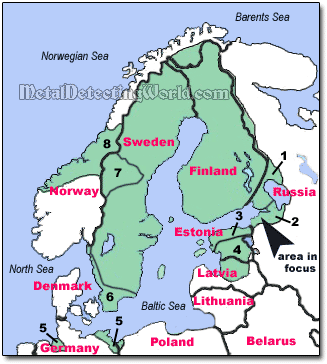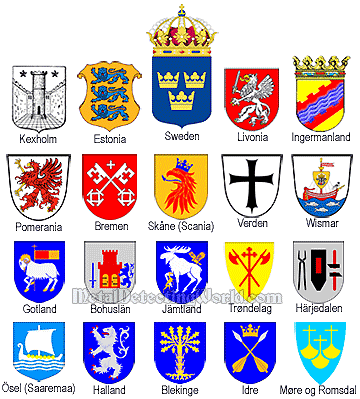Part I - Metal Detecting at the 17th Century Swedish Tavern Site, page 2
Dominions of Sweden in 17th Century
This metal detecting story is based on the events that took place in the western part of the historic land called Ingermanland - a former Swedish dominion.
The dominions of Sweden were territories that historically came under control of the Swedish Crown, but never became fully integrated with Sweden. This generally meant that they were ruled by Governors under the Swedish monarch, but within certain limits retained their own established political systems. The dominions had no representation in the Swedish Riksdag (Parliament).

Swedish Empire at Its Maximum Extent
after the Treaty of Roskilde in 1658
Swedish Dominions shown on map above:
1 - Kexholm-Karela County, 2 - Swedish Ingermanland (Ingria), 3 - Swedish Estonia, 4 - Livonia, 5- Swedish Pomerania, Bremen and Verden, 6 - Scania, Halland, Gotland and Bohuslän, 7 - Jämtland, Härjedalen, Idre and Särna, 8 - Trøndelag and Møre og Romsdal.
Finland was not a dominion, but an integrated part of Sweden. Wismar, Blekinge, Gotland, Ösel and Dagö (Estonian islands Saaremaa and Hiiumaa), and dominions in Prussia, held from 1629 to 1635, are not marked on this map.
Between 1561 and 1629 Sweden made conquests in the Eastern Baltic Sea region: Estonia, Kexholm, Ingria and Livonia. All of them were ceded to Russia in accordance with the Treaty of Nystad only 100 years later, in 1721, at the end of the Great Northern War.
Bremen and Verden were ceded to Hanover in the peace treaty of 1719. Swedish part of Eastern Pomerania (Hinterpommern) with the town of Stettin and the islands of Usedom and Wollin were ceded to Kingdom of Prussia in 1720. Blekinge, Bohuslän, Halland, Härjedalen, Jämtland, Idre, Särna and Scania were gradually incorporated into Sweden by 1721. The region of Trøndelag is, together with Møre og Romsdal, part of Central Norway.

Coats of Arms of Sweden and Its Dominions
In the middle 17th century, a substantial profit from ferrying international trade through the Baltic was a central part of Swedish economic policy - particularly Russian trade, since Sweden's territorial gains have blocked Russia's access to the sea. The founding of the Bank of Sweden in 1668 was an indication of the kingdom's commercial health.
So was the construction of a merchant fleet which amounted at its peak to 730 ships. Equally the building of a strong navy and the maintenance of a massive standing army represented a clear statement of Sweden's new status as a European power. But it proved hard to maintain.
The Swedish gains of the 17th century were at the expense of the Swedish dominions such as Denmark, various states of north Germany, Poland and Russia. The death of King Charles XI in 1697 was followed by secret alliances between Sweden's enemies for coordinated action. The result, beginning in 1700, was the Northern War.